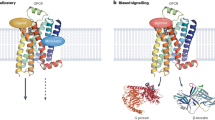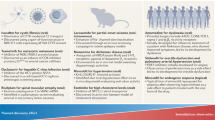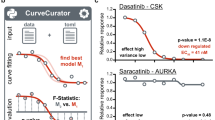Key Points
-
Here, we present an analysis of the origins of all 113 first-in-class drugs approved by the US Food and Drug Administration (FDA) from 1999 to 2013, which shows that the majority (78) of these drugs were discovered through target-based approaches (45 small-molecule drugs and 33 biologics).
-
Only eight of the 33 drugs identified in the absence of a target hypothesis were found by what we define here as 'phenotypic screening': the testing of a large number of compounds in a target-agnostic assay that monitors phenotypic changes. The discovery of the other 25 non-target-based drugs occurred through a chemocentric approach in which compounds with known pharmacology served as the starting point.
-
The median time from first disclosure of the concept (target, pathway or chemotype) to FDA approval was 25 years for non-target-based drugs and 20 years for target-based drugs. All but four of the non-target-based drugs had their origins before 1985, the time around which the technologies necessary for target-based approaches were introduced.
-
We conclude that target-based drug discovery is successful and recognize that high-throughput screening and other innovations applied in the past 25 years have only recently started to have a major impact on new approvals. We further suggest viewing phenotypic screening as a logical evolution of target-based approaches and consider it a novel discipline rather than a neoclassical approach.
Abstract
Analysis of the origins of new drugs approved by the US Food and Drug Administration (FDA) from 1999 to 2008 suggested that phenotypic screening strategies had been more productive than target-based approaches in the discovery of first-in-class small-molecule drugs. However, given the relatively recent introduction of target-based approaches in the context of the long time frames of drug development, their full impact might not yet have become apparent. Here, we present an analysis of the origins of all 113 first-in-class drugs approved by the FDA from 1999 to 2013, which shows that the majority (78) were discovered through target-based approaches (45 small-molecule drugs and 33 biologics). In addition, of 33 drugs identified in the absence of a target hypothesis, 25 were found through a chemocentric approach in which compounds with known pharmacology served as the starting point, with only eight coming from what we define here as phenotypic screening: testing a large number of compounds in a target-agnostic assay that monitors phenotypic changes. We also discuss the implications for drug discovery strategies, including viewing phenotypic screening as a novel discipline rather than as a neoclassical approach.
This is a preview of subscription content, access via your institution
Access options
Subscribe to this journal
Receive 12 print issues and online access
$209.00 per year
only $17.42 per issue
Buy this article
- Purchase on SpringerLink
- Instant access to full article PDF
Prices may be subject to local taxes which are calculated during checkout





Similar content being viewed by others
References
Drews, J. & Ryser, S. The role of innovation in drug development. Nature Biotech. 15, 1318–1319 (1997).
Garnier, J. P. Rebuilding the R&D engine in big pharma. Harv. Bus. Rev. 86, 68–70 (2008).
Douglas, F. L., Narayanan, V. K., Mitchell, L. & Litan, R. E. The case for entrepreneurship in R&D in the pharmaceutical industry. Nature Rev. Drug Discov. 9, 683–689 (2010).
David, E., Tramontin, T. & Zemmel, R. Pharmaceutical R&D: the road to positive returns. Nature Rev. Drug Discov. 8, 609–610 (2009).
Paul, S. M. et al. How to improve R&D productivity: the pharmaceutical industry's grand challenge. Nature Rev. Drug Discov. 9, 203–214 (2010).
Kola, I. & Landis, J. Can the pharmaceutical industry reduce attrition rates? Nature Rev. Drug Discov. 3, 711–715 (2004).
Ruffolo, R. R. Why has R&D productivity declined in the pharmaceutical industry? Expert Opin. Drug Discov. 1, 99–102 (2006).
Scannell, J. W., Blanckley, A., Boldon, H. & Warrington, B. Diagnosing the decline in pharmaceutical R&D efficiency. Nature Rev. Drug Discov. 11, 191–200 (2012). This article discusses four factors as the primary causes of the decline in pharmaceutical R&D efficiency.
Munos, B. Lessons from 60 years of pharmaceutical innovation. Nature Rev. Drug Discov. 8, 959–968 (2009).
Horrobin, D. F. Realism in drug discovery — could Cassandra be right? Nature Biotech. 19, 1099–1100 (2001).
Pammolli, F., Magazzini, L. & Riccaboni, M. The productivity crisis in pharmaceutical R&D. Nature Rev. Drug Discov. 10, 428–438 (2011).
Swinney, D. C. & Anthony, J. How were new medicines discovered? Nature Rev. Drug Discov. 10, 507–519 (2011). This article analyses the origins of first-in-class drugs (FDA approvals from 1999 to 2008) and postulates that target-based drug discovery contributes to low productivity in pharmaceutical R&D.
Butcher, E. C. Can cell systems biology rescue drug discovery? Nature Rev. Drug Discov. 4, 461–467 (2005).
Hellerstein, M. K. A critique of the molecular target-based drug discovery paradigm based on principles of metabolic control: advantages of pathway-based discovery. Metab. Eng. 10, 1–9 (2008).
Kell, D. B. Finding novel pharmaceuticals in the systems biology era using multiple effective drug targets, phenotypic screening and knowledge of transporters: where drug discovery went wrong and how to fix it. FEBS J. 280, 5957–5980 (2013).
Zheng, W., Thorne, N. & McKew, J. C. Phenotypic screens as a renewed approach for drug discovery. Drug Discov. Today 18, 1067–1073 (2013).
Swinney, D. C. Phenotypic versus target-based drug discovery for first-in-class medicines. Clin. Pharmacol. Ther. 93, 299–301 (2013).
Schrör, K. Acetylsalicylic Acid (Wiley, 2009).
Sneader, W. Drug Discovery: A History (Wiley, 2005).
Macarron, R. et al. Impact of high-throughput screening in biomedical research. Nature Rev. Drug Discov. 10, 188–195 (2011).
Beck, A., Wurch, T., Bailly, C. & Corvaia, N. Strategies and challenges for the next generation of therapeutic antibodies. Nature Rev. Immunol. 10, 345–352 (2010).
Algire, G. H. & Chalkley, H. W. Vascular reactions of normal and malignant tissues in vivo.1. Vascular reactions of mice to wounds and to normal and neoplastic transplants. J. Natl Cancer Inst. 6, 73–85 (1945).
Greenblatt, M. & Shubk, P. Tumor angiogenesis — transfilter diffusion studies in hamster by transparent chamber technique. J. Natl Cancer Inst. 41, 111–124 (1968).
Folkman, J. Tumor angiogenesis — therapeutic implications. N. Engl. J. Med. 285, 1182–1186 (1971).
Senger, D. R. et al. Tumor cells secrete a vascular permeability factor that promotes accumulation of ascites fluid. Science 219, 983–985 (1983).
Leung, D. W., Cachianes, G., Kuang, W. J., Goeddel, D. V. & Ferrara, N. Vascular endothelial growth factor is a secreted angiogenic mitogen. Science 246, 1306–1309 (1989).
Presta, L. G. et al. Humanization of an anti-vascular endothelial growth factor monoclonal antibody for the therapy of solid tumors and other disorders. Cancer Res. 57, 4593–4599 (1997).
Buchdunger, E. et al. Inhibition of the Abl protein-tyrosine kinase in vitro and in vivo by a 2-phenylaminopyrimidine derivative. Cancer Res. 56, 100–104 (1996).
Nowell, P. C. & Hungerford, D. A minute chromosome in human chronic granulocytic leukemia. Science 132, 1497 (1960).
Rowley, J. D. New consistent chromosomal abnormality in chronic myelogenous leukemia identified by quinacrine fluorescence and Giemsa staining. Nature 243, 290–293 (1973).
Shtivelman, E., Lifshitz, B., Gale, R. P. & Canaani, E. Fused transcript of abl and bcr genes in chronic myelogenous leukemia. Nature 315, 550–554 (1985).
Burnett, D. A. et al. 2-Azetidinones as inhibitors of cholesterol absorption. J. Med. Chem. 37, 1733–1736 (1994).
Hopkins, A. L. & Groom, C. R. The druggable genome. Nature Rev. Drug Discov. 1, 727–730 (2002).
Lokey, R. S. Forward chemical genetics: progress and obstacles on the path to a new pharmacopoeia. Curr. Opin. Chem. Biol. 7, 91–96 (2003).
Hall, S. E. Chemoproteomics-driven drug discovery: addressing high attrition rates. Drug Discov. Today 11, 495–502 (2006).
Pruss, R. M. Phenotypic screening strategies for neurodegenerative diseases: a pathway to discover novel drug candidates and potential disease targets or mechanisms. CNS Neurol. Disord. Drug Targets 9, 693–700 (2010).
St Onge, R., Schlecht, U., Scharfe, C. & Evangelista, M. Forward chemical genetics in yeast for discovery of chemical probes targeting metabolism. Molecules 17, 13098–13115 (2012).
Heitman, J., Movva, N. R. & Hall, M. N. Targets for cell cycle arrest by the immunosuppressant rapamycin in yeast. Science 253, 905–909 (1991).
Sams-Dodd, F. Is poor research the cause of the declining productivity of the pharmaceutical industry? An industry in need of a paradigm shift. Drug Discov. Today 18, 211–217 (2013). This paper discusses potential reasons for the high failure rate of target-based drug discovery and suggests changes to improve productivity.
Lee, J. A. & Berg, E. L. Neoclassic drug discovery: the case for lead generation using phenotypic and functional approaches. J. Biomol. Screen. 18, 1143–1155 (2013).
Carragher, N. O., Brunton, V. G. & Frame, M. C. Combining imaging and pathway profiling: an alternative approach to cancer drug discovery. Drug Discov. Today 17, 203–214 (2012).
Lee, J. A., Uhlik, M. T., Moxham, C. M., Tomandl, D. & Sall, D. J. Modern phenotypic drug discovery is a viable, neoclassic pharma strategy. J. Med. Chem. 55, 4527–4538 (2012).
Chatterjee, A. K. & Yeung, B. K. Back to the future: lessons learned in modern target-based and whole-cell lead optimization of antimalarials. Curr. Top. Med. Chem. 12, 473–483 (2012).
Payne, D. J., Gwynn, M. N., Holmes, D. J. & Pompliano, D. L. Drugs for bad bugs: confronting the challenges of antibacterial discovery. Nature Rev. Drug Discov. 6, 29–40 (2007).
Fishman, M. C. & Porter, J. A. Pharmaceuticals: a new grammar for drug discovery. Nature 437, 491–493 (2005).
Welch, E. M. et al. PTC124 targets genetic disorders caused by nonsense mutations. Nature 447, 87–91 (2007).
Rottmann, M. et al. Spiroindolones, a potent compound class for the treatment of malaria. Science 329, 1175–1180 (2010).
Butchbach, M. E. et al. Effects of 2,4-diaminoquinazoline derivatives on SMN expression and phenotype in a mouse model for spinal muscular atrophy. Hum. Mol. Genet. 19, 454–467 (2010).
Chen, B. et al. Small molecule-mediated disruption of Wnt-dependent signaling in tissue regeneration and cancer. Nature Chem. Biol. 5, 100–107 (2009).
Filippakopoulos, P. et al. Selective inhibition of BET bromodomains. Nature 468, 1067–1073 (2010).
Gao, M. et al. Chemical genetics strategy identifies an HCV NS5A inhibitor with a potent clinical effect. Nature 465, 96–100 (2010). This paper describes the discovery of daclatasvir (BMS-790052) by phenotypic screening and further chemical optimization in the absence of target knowledge.
Naylor, L. H. Reporter gene technology: the future looks bright. Biochem. Pharmacol. 58, 749–757 (1999).
Chiba, T., Tsuchiya, T., Mori, R. & Shimokawa, I. Protein reporter bioassay systems for the phenotypic screening of candidate drugs: a mouse platform for anti-aging drug screening. Sensors 12, 1648–1656 (2012).
Williams, M. Systems and integrative biology as alternative guises for pharmacology: prime time for an iPharm concept? Biochem. Pharmacol. 70, 1707–1716 (2005).
Ogbourne, S. M. et al. Antitumor activity of 3-ingenyl angelate: plasma membrane and mitochondrial disruption and necrotic cell death. Cancer Res. 64, 2833–2839 (2004).
Lock, E. A. et al. From toxicological problem to therapeutic use: the discovery of the mode of action of 2-(2-nitro-4-trifluoromethylbenzoyl)-1,3-cyclohexanedione (NTBC), its toxicology and development as a drug. J. Inherit. Metab. Dis. 21, 498–506 (1998).
Coe, J. W. et al. Varenicline: an α4β2 nicotinic receptor partial agonist for smoking cessation. J. Med. Chem. 48, 3474–3477 (2005).
Kessel, D., Hall, T. C. & Wodinsky, I. Transport and phosphorylation as factors in the antitumor action of cytosine arabinoside. Science 156, 1240–1241 (1967).
Gudas, L. J., Ullman, B., Cohen, A. & Martin, D. W. Jr. Deoxyguanosine toxicity in a mouse T lymphoma: relationship to purine nucleoside phosphorylase-associated immune dysfunction. Cell 14, 531–538 (1978).
Cohen, A., Lee, J. W. & Gelfand, E. W. Selective toxicity of deoxyguanosine and arabinosyl guanine for T-leukemic cells. Blood 61, 660–666 (1983).
Lambe, C. U. et al. 2-amino-6-methoxypurine arabinoside: an agent for T-cell malignancies. Cancer Res. 55, 3352–3356 (1995).
Katz, D. H., Marcelletti, J. F., Khalil, M. H., Pope, L. E. & Katz, L. R. Antiviral activity of 1-docosanol, an inhibitor of lipid-enveloped viruses including herpes simplex. Proc. Natl Acad. Sci. USA 88, 10825–10829 (1991).
Szelenyi, I. Flupirtine, a re-discovered drug, revisited. Inflamm. Res. 62, 251–258 (2013).
Acknowledgements
The authors are grateful to I. Jones for expert help in statistical analysis, and thank their colleagues at the Novartis Institutes for Biomedical Research for the stimulating discussions related to this work. The authors also thank M. C. Fishman for making valuable suggestions on the content and scope of the analysis, and U. Eder for important insights into general aspects of pharmaceutical research.
Author information
Authors and Affiliations
Corresponding author
Ethics declarations
Competing interests
All authors are employees of Novartis Pharma AG.
Supplementary information
Supplementary information S1 (table)
Characteristics and origins of first-in-class drugs approved by the US FDA: 1999–2013 (PDF 1759 kb)
Supplementary information S2 (box)
Approval times for target-based and systems-based first-in-class drugs: 1999–2013 (PDF 274 kb)
Related links
Glossary
- First-in-class drugs
-
Drugs that modulate an as-yet unprecedented drug target or biological pathway.
- Phenotypic screening
-
The testing of a large number of — in most cases randomly selected — compounds in a systems-based assay.
- Target-based approaches
-
Hypothesis-based approaches that aim to manipulate a biological system bypharmacologically modulating a specific component or target (an enzyme, receptor, and so on).
- Small-molecule drugs
-
Drugs with a low molecular mass (typically <1,000 Da); this includes synthetic drugs, natural products (or derivatives) and natural substances (or derivatives).
- Systems-based approach
-
Hypothesis-agnostic assay or approach that monitors or is based on a phenotypic change in vitro or in vivo.
- Chemocentric approaches
-
Drug discovery approaches based around a specific compound or compound class. Chemocentric approaches have made a substantial contribution both to drugs originating from systems-based approaches and to drugs originating from target-based approaches.
- Natural substance (or derivative)
-
A chemical substance (or derivative thereof) produced by a living organism found in nature that usually has pharmacological or biological activity. For this article we arbitrarily excluded natural products from natural substances to keep the former as a separate class of compounds.
- Biologics
-
Defined here as all drugs approved under a biologics license application (BLA) by the US Food and Drug Administration (FDA); usually antibodies and other proteins.
- Chemotype
-
A family of molecules that possess the same core structure or scaffold.
- Natural product (or derivative)
-
Secondary metabolites (or derivatives thereof) that are extracted from tissues of plants, marine organisms or microorganism fermentation broths.
- Pharmacophore
-
The steric and electronic features of a ligand that are necessary to ensure optimal interactions with a biological target structure and to trigger (or to block) its biological response.
- Low-molecular-mass synthetic drug
-
Low-molecular-mass drugs that are not derived from natural products or natural substances.
Rights and permissions
About this article
Cite this article
Eder, J., Sedrani, R. & Wiesmann, C. The discovery of first-in-class drugs: origins and evolution. Nat Rev Drug Discov 13, 577–587 (2014). https://doi.org/10.1038/nrd4336
Published:
Issue Date:
DOI: https://doi.org/10.1038/nrd4336



